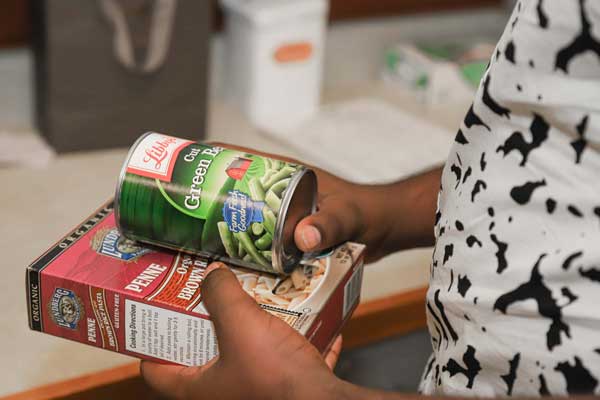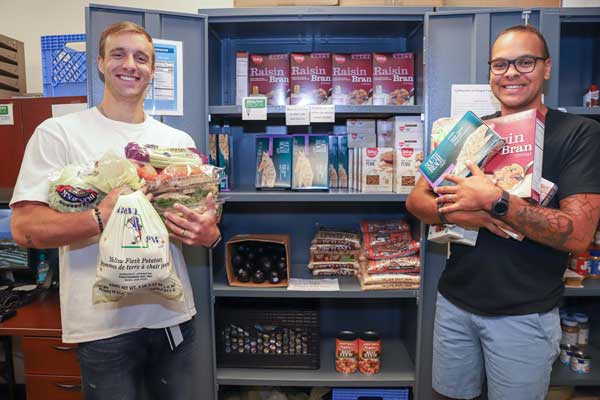LEARNING ON EMPTY
Food pantry use at Reno-Tahoe colleges skyrockets.
Written by Annie Flanzraich
Photos by Shaun Hunter
The Thursday before Truckee Meadows Community College’s fall 2019 semester began, Jessica Cates studied the blue metal shelves at the campus food pantry, the Wizard’s Warehouse.
Cates, a student working toward her associate of science degree in personal training and entrepreneurship, inspected each label. She selected a box of organic, gluten-free, non-GMO crackers and placed it in a neon-green cloth bag with TMCC’s logo. Then she eyed the organic tomatoes in the pantry’s fridge.
“They have a lot of good stuff, healthy stuff,” Cates says.
Nutrition and ingredients matter to Cates. She has brain cancer, and her 7-year-old daughter, Annabella, has Down syndrome. But budget matters, too.
“SNAP only gives me $80 a week, and that’s not enough,” Cates says.
The weekly visits to the Wizard’s Warehouse for dry goods, produce, and protein keep Cates and Annabella fed.
“Knowing I can come in here and get some food, I can’t even tell you how that relieves some stress,” Cates says. “It means everything.”
The food pantry also fuels Cates while she works toward her degree.
“It’s hard to study when you’re hungry,” she says.

Darwin Snyder, UNR Pack Provisions volunteer (right), helps Sivakumar select food from the pantry
Hungry for knowledge
Cates is one of the 56 percent of United States community college students who are food insecure, according to The Hope Center for College, Community, and Justice. In 2018, the research center released the results of a national survey of 43,000 students at 66 institutions showing that 36 percent of university students were food insecure.
According to the survey, food insecurity is “the limited or uncertain availability of nutritionally adequate and safe foods, or the ability to acquire such foods in a socially acceptable manner.”
In the greater Reno-Tahoe region, almost every higher education institution offers an on-campus program to address food insecurity or is studying how the issue affects its students.
At the University of Nevada, Reno, 22 percent of students surveyed in 2018 said they had inconsistent or insufficient access to food. Leaders at TMCC plan to complete a similar campus-wide survey by the end of the 2020 school year, says Estella Levario Gutierrez, president of student services and diversity. Western Nevada College in Carson City also will survey student hunger this year, says President Vincent Solis.
“Even the lowest number of students is far too many students to be going hungry,” Solis says.
At California community colleges in Truckee and South Lake Tahoe, almost 50 percent of students could be food insecure, according to a California Community Colleges survey conducted by The Hope Center.
“You’ve always heard about the starving college student like it was just supposed to be part of the experience, but it shouldn’t be,” says Jocelyn Lantrip, director of marketing and communications for the Food Bank of Northern Nevada in Reno. “They’re trying to improve their lives, but it is an expensive endeavor.”
The FBNN provides food to UNR and TMCC’s food pantries.
Food insecurity is correlated with lower grades in college and can threaten the very education for which students are sacrificing.
“If you are hungry, how are you supposed to study or do any of the things that are expected of you?” asks Kim Bateman, the executive dean of Sierra College’s Tahoe-Truckee campus.

Kavin Sivakumar, a student-visitor at the University of Nevada, Reno’s Pack Provisions, selects food
Feeding the pack
At UNR, use of the campus food pantry, Pack Provisions, has grown by more than 4,000 percent between the 2015-2016 and 2018-2019 school years. The number of Pack Provisions visitors jumped from 58 to 2,607 people during those three years, according to the FBNN.
University officials attribute the exponential growth to having changed the pantry’s operations, more marketing, and higher awareness on campus.
At the beginning of 2019, Pack Provisions moved from a small closet with a roll-up window to a large, browsable space.
“We’re trying to remove as many obstacles as we can to make students feel more comfortable,” says Wei Deng, the student director of Pack Provisions.
While Pack Provisions’ location may have changed, its philosophy has not. Anyone associated with the UNR campus, from faculty members to students, can use the food pantry. Individuals are asked to fill out an intake form the first time, but the information is only for data purposes. There is no income or qualification threshold. No one gets turned away.
Deng recalled a student with broken glasses who almost had to choose between seeing and eating. Instead, the student visited Pack Provisions and didn’t have to make that choice.
“This one unfortunate event happened, and that could happen to any of us,” Deng says. “That’s why we don’t have an income level cutoff. Food insecurity can happen to anyone.”
Pack Provisions’ food comes from several sources, including the FBNN. The food pantry received $10,000 from the UNR student government in 2018-2019 to supplement items such as protein. The university’s Desert Farming Initiative provides fresh produce when available. In addition to food, Pack Provisions offers hygiene items and school supplies for students.
The food pantry also holds a monthly farmers’ market-style event called Mobile Monday, which provides free, fresh produce and nutritional education to students.
While campus leaders have been supportive of and receptive to Pack Provisions, students have encountered outside individuals who questioned the need for a campus food pantry, says Amy Koeckes, the associate director of student engagement.
“Some of the comments were, ‘Well, can’t they just ask their parents for money?’” Koeckes says. “But sometimes that’s not the case. There are a lot of assumptions in that question.”
Feeding the community
At TMCC, food pantry use also has dramatically increased over the past few years. During the 2016-2017 school year, 1,657 people used the Wizard’s Warehouse. In the 2018-2019 school year, that number rose to 2,672.
“We’re speculating it’s because of housing costs,” Levario Gutierrez says. “The rent prices have skyrocketed.”
Average rents in Reno have increased by almost 30 percent since 2016, according to Johnson Perkins Griffin LLC, a real estate appraisal company that documents rental trends in Reno.
The college will have more answers regarding food insecurity and its causes once it completes its planned survey this year.
Like UNR, TMCC leaders also have changed the food pantry to make it more accessible to all students, says Cameron Tuttle, the counseling coordinator and wellness and prevention committee chair. The Wizard’s Warehouse operates similarly to Pack Provisions in that it doesn’t restrict use based on income or other qualifiers.
“We don’t want students to feel embarrassed,” Levario Gutierrez says. “We want to make it as comfortable as possible.”
Students can browse the food pantry and hygiene items freely, taking what they need.
“If our students are hungry, they need food so they can be successful at school,” Tuttle says.
Other community colleges in the region have launched food pantries in response to student food insecurity.
Lake Tahoe Community College in South Lake Tahoe created a food pantry in 2018. In its first year, 65 people used the pantry. The campus’ population is about 2,000.
At Sierra College’s Tahoe-Truckee Campus, 80 percent of the 650 students who attend qualify for free or reduced tuition. When the campus started a food pantry in January 2019 with the help of the Sierra Community House, about 30 students went in each day to use it.
“The faculty feels really good that we’re taking better care of our students,” Bateman says. “And the students have big smiles when they’re getting their Cup Noodles.”
__________________
Annie Flanzraich is a Reno-based freelance writer and a graduate of the University of Nevada, Reno.


